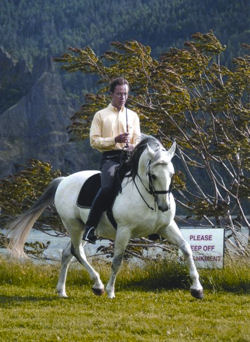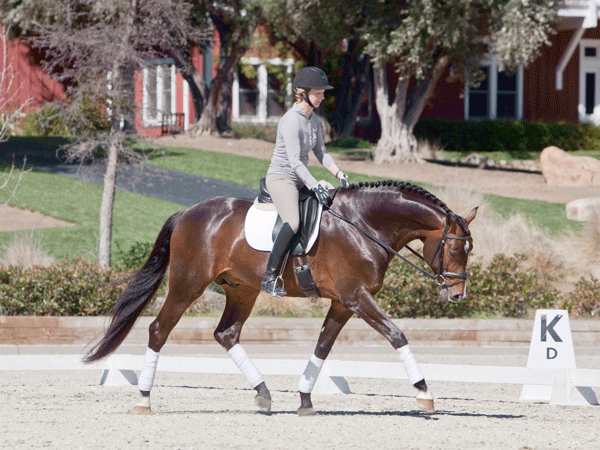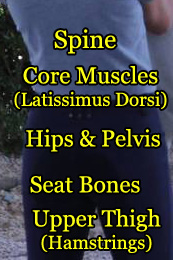
The Not-So-Secret, Secret Dressage Training Formula Article
THE BASIC GUIDING PRINCIPLES IN DRESSAGE TRAINING
You see this absolutely amazing dressage horse floating effortlessly around the arena. The rider looks to be doing little more than sitting there. And you think to yourself, “Why doesn’t it ever look like that when I do it?” Admit it. We’ve all been there.
Now, we all know better than to think that the horse is doing this beautifully choreographed routine of his own accord and that the rider is merely a passenger. The effort and concentration required of both horse and rider in dressage is paramount. The hours and years that go into such a high level performance can be daunting, especially when you are at the beginning staring at the enormous dressage mountain.
So, what does it take to be successful? How do we get there? The concepts for reaching the top in the sport are quite simple. The execution of those concepts; however, can be quite challenging – especially if you have a less-than-perfect, moody, or opinionated horse. Compound that with horse’s physical ability, his emotional state and history, the rider’s nature and physical ability and the heaps of ambiguous, somewhat confusing, vague information that exists and most rider’s concede that the pinnacle of dressage riding is nothing more than a pipe dream.
NOT TRUE. That’s right, it is not just a pipe dream. It is a legitimate goal that any rider and any horse can achieve. It takes persistence, patience and a clearly defined plan, but it is definitely attainable. I know you are probably thinking that I have lost my mind about now. But I assure you, that I have done no such thing. Let me explain the not-so-secret, secret to training an upper level dressage horse:
HARD WORK + TIME + TRAINING PYRAMID = DRESSAGE MASTER
(persistence) + (patience) + (clearly defined plan) = pinnacle of dressage
Let’s examine each element individually.
HARD WORK
It goes without saying that Dressage takes an enormous amount of work. Both parties in the partnership have to be committed to the effort. Let’s face it, dragging your horse kicking and neighing to the top of the mountain is not going to be very much fun. Not to mention, he will get really heavy.
But how do we ensure that both partners are committed to the task at hand. Well, the K.I.S.S method tends to work well. Keep. It. Simple. Stupid. If you look at the complexity of this process as a whole, you and your horse will undoubtedly become overwhelmed. Breaking the trip into manageable segments will make it more enjoyable. Designing exercises that allow the horse to take baby steps and experience success will ultimately pay off.
Secondly, Enjoy the Ride – no pun intended. I charge you with the task of making your rides enjoyable for both you are your horse. Creating variety in your work sessions that build incrementally will allow your horse to develop skills without creating negative tension. Using a consistent, long and low, warm up and cool down will also help to maintain the necessary elements of the training pyramid. That being said, you will still experience speed bumps along the way. Injuries, illness, and even emotional drain can often take hold. The emotional side can definitely take hold when training is not progressing as you intend – SEE PART 2 OF THE EQUATION.
TIME
IT’S NOT ABOUT YOU!!! Ouch… That statement can be hard to swallow. After all, you have poured your heart and soul into this horse and the pursuit of this dream. So, what do you mean, “It’s not about me”?
Well, if you have ever raised a child, you know that those monumental stages in life (i.e. – the first step, the first word, the first word, etc.) don’t always happen when you expect. The same is true in your dressage journey. Every horse and every rider will experience challenges throughout the training process. And, every horse and every rider learn at a different pace. Each has things they are naturally good at and things that really perplex them. As a result, it is extremely difficult to nail down a definitive time frame.
Someone once said that, “The perfect horse, with the perfect rider, the perfect trainer and perfect training program will still take approximately 8-10 years to reach the top.”
Wow, that’s a lot of perfects.
So what does that mean? It means don’t lock yourself into a timetable. You will set yourself and your horse up for failure.
Now, wait just a minute, “Are you saying that I can’t set goals with deadlines? That goes against every goal-setting course and rule I’ve ever heard.”
No, I am not saying that you can’t set goals with deadlines. I am saying that you have to be flexible. Your ability to adapt to the challenges that you face will take you pretty far down the road to dressage success. This process is ever changing and ADAPTABILITY is the name of the game.
THE DRESSAGE TRAINING PYRAMID
Finally, we get to the heart of dressage success – THE TRAINING PYRAMID.
Rhythm, Relaxation, Connection/Contact, Impulsion, Straightness, Collection – or –
Takt, Losgelassenheit, Anlehnung, Schwung, Geraderichten, Sersammlung (for our German-speaking audience)
The training pyramid, as illustrated nearly everywhere, provides a linear way of thinking. The very nature of dressage training; however, is not linear. Rather it is an interconnected relationship that promotes the overall physical, mental and psychological development of the horse. So, if all aspects are truly interrelated, then why do we use a pyramid to represent the concepts?
This structure serves only as a template for training the horse – they are building blocks of the training program. This concept often causes great confusion for those starting out in the sport. Because the training process is represented by a pyramid, one is often left to believe that higher levels are only started once preceding levels are mastered. This is not the case at all. As a matter of fact, the exact opposite is true. As the horse progresses through its training, the levels below are refined as a means of improving the current level. If a previous level is not refined, mastery of the proceeding levels is impossible. This clearly presents the case that all levels of the training pyramid are interconnected.
Surprisingly, all levels are started in some fashion very early in the training process. Albeit, the degree of execution may not epitomize the final outcome, each level is ever-present throughout the training of the dressage horse and rider. For example:
Teaching the half halt introduces a level of collection, impulsion, connection/contact, straightness, rhythm and relaxation.
The 20-meter circle presents rhythm, relaxation, connection/contact, impulsion and straightness.
The full halt demonstrates connection/contact, impulsion, collection, straightness and suppleness.
Each of these movements are introduced in the very beginning phases of training, and yet, the upper levels of the training pyramid are present. How is that possible?
Simple. The Dressage Training Pyramid is not a guideline for how to train, but rather what to develop. The pyramid outlines the key elements that must be present in every dressage horse. Just as with our own development, certain characteristics become more apparent and prominent as we develop in other areas. This is equally true for the dressage horse. The horse will enhance and further develop each aspect of the training pyramid throughout his journey because of the synchronous relationship between the elements.
HOW DOES THAT WORK?
If the dressage training pyramid is not a training program for the dressage horse, then how do we use it to train our horses?
The dressage training pyramid provides us with a concrete idea of where we are going (the big picture). It is similar to a big picture map. The map shows us where places are in relation to others, but we are free to choose which route best suits us for getting to our destination. The same is true for training the horse.
The not-so-secret, secret dressage training formula is that there is NO DETAILED MAP. UGHHHHH!!! Say it with me, “UUUUGGGGGHHHHH!!!”
How can that be? And why did I waste a ½ hour for you to tell me that. I’m no further ahead now than I was before. So, what’s the point?
Now, that we are done having our little meltdown. Let’s think about what this means to you and your horse. Chances are you don’t have a multi-million dollar horse and your facilities are not necessarily world-class (ok, some of you are lucky enough to have these things, but the majority do not). Despite this fact, you can still achieve the highest levels of success in this sport.
Yes, you can reach the top.
The point is that there are specific characteristics (HINT: Those listed in the training pyramid) that must be present in your dressage horse in order for you to achieve success. And these characteristics can be molded and shaped in every horse. The degree to which they are developed is dependent upon the horse’s personality, his physical ability, the relationship that you develop with your horse and the methods that you employ.
The benefit to having a clearly defined plan instead of a detailed map is that you are free to take detours and excursions to help you reach your destination. Yes, you have to develop a training plan and program that are suitable for your horse and you. Yes, you have to live within the constraints that have been set. But you are free to enjoy the journey instead of always looking at the map. This allows you to accommodate you and your horse’s individual strengths, weaknesses and learning styles.
You also have the benefit of having nearly unlimited educational resources to help you reach your destination. There are plenty of books, videos, trainers, clinicians and online sources for information and ideas. If one plan is not working, do some research and take another route.
Closing
We are here for you every step of the way. We understand how challenging, frustrating and confusing training a dressage horse can be. Fears often creep in and tell us it’s impossible. Let us be the first to tell you, it is not impossible. You have taken the first step toward achieving your dreams and we salute you. Over the next several months, we will be looking deeper into the individual levels of the training pyramid and discussing the development of an effective training program. We are excited that you have chosen to join us on this amazing journey. Please let us know how we can help you and your horse reach your greatest potential.
Happy riding.
Author: Dressage Academy
You May Also Like

Rejuvenate Your Dressage Horse
July 6, 2017
Long and Low – The Foundation of All Good Dressage Training
October 25, 2017